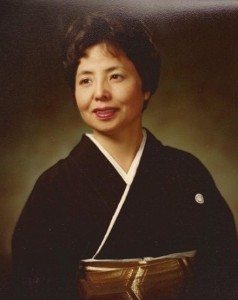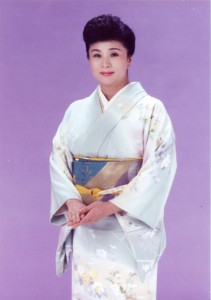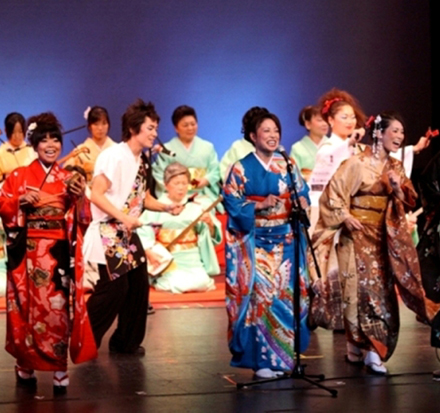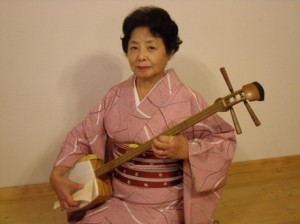2010: Japanese folk music association led by Matsutoyo Sato to celebrate its 45th anniversary with a concert, Nov. 14

Matsutoyo Kai Japanese folk music association will present the 45th anniversary concert. (Courtesy of the artists)
Cultural News, 2010 September Issue
To celebrate its 45th anniversary, the Matsutoyo Kai, a leading Japanese folk music association in Los Angeles and San Francisco led by Mme. Matsutoyo Sato, will present Japanese Folk Music Festival with guest artist Kosugi Makiko of Japan on Sunday, November 14, at 1:00 pm at the James Armstrong Theatre, 3330 Civic Center Drive, Torrance, CA 90503. Tickets are $20. For tickets, call Matsutoyo Kai at (310) 538-0334 or the box office at (310) 781-7171 or email MarisaKosugi@hotmail.com.
Matsutoyo Sato studied European music and opera in Osaka for 10 years as a child. At 16 she was formally exposed to minyo (Japanese folk music), shigin (recitation of Chinese-style poem), and the biwa (four-stringed lute). By age 20, her instructors strongly encouraged her to apprentice under Mme. Matsuko Sato in Tokyo, the late Iemoto, or Grand Master of the Sato School.

Mmr. Matsutoyo Sato, founder and artistic director of the Mtsutoyo Kai Japanese folk music association. (Courtesy of the artist)
During this time, she embraced and excelled in a variety of traditional music genres such as minyo (folk song), minbu (dance), nagauta (Kabuki song), hauta (Short shong with shamisen), and zokkyoku (ballads). Her skill and determination allowed her talents to be recognized with performances on both local and national NHK televisions and radio programs, and various stage performances throughout Japan.
Matsutoyo Sato came to San Francisco in 1966 and established the Matsutoyo Kai Minyo Group. She dedicated herself to teaching and promoting Japanese folk music culture to the Northern California area.
Within 10 years, she had taught and certified over 150 students to attain natori, or professional performer status.
In 1976, Matsutoyo Sato moved to Los Angeles in hopes of grasping new hearts with this Japanese art, setting up classes and performances throughout Los Angeles, Orange, and San Diego counties.
Matsutoyo Sato has performed on the Gypsy Rose Lee Show on a San Francisco television program, films such as The Karate Kid II, and various television commercials.
Today, Matsutoyo Sato continues to teach and pass on her knowledge, passion, and expertise in traditional minyo throughout Northern and Southern California. The Matsutoyo Kai also maintains a busy schedule of public performances in Japanese folk and classical music throughout the year. In 2006 Matsutoyo Kai became a nonprofit organization.
Folk songs are universal songs passed down for many generations. While Japan had been a maritime country, it was also an agricultural country centered on rice farming. In Japan, work songs have been the mainstream of folk songs. Their lyrics often started with a prayer for a good harvest and prosperity.
Folk songs have breathed the lives of people in a free environment, with no need for special protection for a long time. Even in a small, narrow country such as Japan, from ancient times people have passed on many songs that were cherished in their local land and climate. The prayers of true hearts and old emotions have thus survived.
Folk songs are a form of “encyclopedia” for understanding Japan, and one can think that singing folk songs contributes to the upbringing of Japanese people from childhood. A folk song is much the same as a natural and beautiful plant or flower that is not on public display or shown to an audience.
For more information about the Matsutoyo Kai visit www.matsutoyokai.org and www.MySpace.com/MatsutoyoKai213
Japanese Folk Music Festival
The Japanese Folk Music Festival will feature King Record artist Mme. Makiko Kosugi of Japan and Minyo Station consisting younger members of Matsutoyo Kai.
Minyo Station is in the forefront of a movement to infuse a new sound into traditional Japanese folk music, as interpreted by a new generation of artists. Like the wind, the sound of minyo blows freely from the East to the West. Minyo Station’s sound is both unique yet familiar, a multicultural “twist” that melds Western elements of genre such as rock, R&B, and jazz with melodies and structure of minyo compositions that have been passed down for generations through the many villages of Japan.
The programs to be performed by the members of the Matsutoyo Kai are as follows:
Shojyu Sanbaso (Happiness of the Everlasting Pine) with dance performance by Bando Hiromiya and Bando Hirosuzu; Kumamoto Jitensha Bushi (Kumamoto Bicycle Song); Kuroishi Yosare Bushi (Wonderful Kuroishi); Oedo Nihonbashi (Journey from the Bridge Nihonbashi);
Taishokoto (two-stringed small-size koto) performance); Dounan Bon-uta (Obon Song – Sending off from Dounan of Hokkaido); Yamanaka Bushi (Song of Yamanaka); Tawara Tsumi Uta (Stacking Rice Sack Song) with dance performance by Matsutoyosei Troupe; Chatkiri Bushi (Tea picking Song); Nagoya Jinku (Ballad of Nagoya); Shin-Densa Bushi (New Densa Song);
Harusame (Hauta-genre: Spring Rain) with dance performance by Bando Hidesomi Troupe; Akita Bushi (Song of Akita); Tottori Shanshan Kasa Odori (Tottori Hat Dance) with dance performance by Matsutoyosei Troupe; Fujimurasaki (Yamatogaku-genre: Wisteria) with dancer Bando Hidesomi;
Tawarazaka (Historical Tawarazaka); Sansa Shigure (Auspicious Celebratory Song – Autumn Drizzle); Ichikawa Monju (Bon Odori Song of Ichikawa Monju); Nagasaki no Nana Fushigi (Seven Wonders of Nagasaki); Inaba no Daikoku Mai (Dance for the God at Inaba); Kujyu Kogen (Kujyu Plains);
Ume nimo Haru (Coming of Spring to the Plum Trees) with dance performance by Bando Mitsuhiro Troupe; Iyou Bushi (Discourse at Iyou) with dance performance by Ehime Kenjinka members; Ushibuka Hanya (Joyful Ushibuka) with dance performance by Bando Hidesomi Troupe and Matsutoyosei Troupe;
Odatsuki Sansagari Sawagi (Joyous Music); Fukagawa (Hauta-genre: Fukagawa) with dance performance by Bando Hiroyuki and Bando Hirokaori; Isohara Bushi (Song of the Beautiful Isohara Seashore); Takeda no Komori Uta (Lullaby from Takeda); Aizu Bandaisan (Obon Dance from Mt. Aizu Bandai); Yosakoi Naruko Odori (Joyful Naruko Dance).



